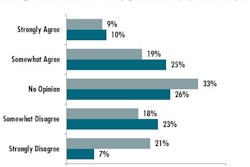Though parts of the US Midwest have finally received some rain over the last few weeks, it's a case of too little, too late. The 2012 US drought has done irreparable damage to this year's crops of corn, soybeans and other grains (and the farmers who grow them) and will likely have a long-lasting impact on meat supplies and prices, too. This will definitely affect the prices of food, feed and, likely, petfood in the near future; food prices are already soaring in some parts of the world.
This week the World Bank released a report saying corn now costs US$300 per metric ton -- a doubling in price from 2010 -- and soybeans are now at US$600 per metric ton, doubling over the past five years. Both prices are all-time highs, causing global food prices to increase 10%, the Los Angeles Times reported, and leading to severe challenges around the world but especially in the Middle East and Africa. The World Bank blames the crisis on the ongoing drought and dryer than normal summers in not just the US but also Russia and India.
Similarly, in August the United Nations' Food and Agriculture Organization (FAO) said that rising grain, corn and sugar prices have increased its food price index by 6%. This week it released a statement in conjunction with the International Fund for Agricultural Development and the World Food Programme calling for world players to tackle the root causes of high food prices and the resulting hunger.
While the joint statement is mostly about human food, I believe several passages apply to feed and petfood, too:
"Until we find the way to shock-proof and climate-proof our food system, the danger will remain. In the short term, this has costs, not only for those directly impacted, but also for the international community at large. ... We are vulnerable because even in a good year, global grain production is barely sufficient to meet growing demands for food, feed and fuel -- this, in a world where there are 80 million extra mouths to be fed every year. We are at risk because only a handful of nations are large producers of staple food commodities, and when they are affected, so is everyone else.
"The challenge -- and the opportunity -- is both to reduce and to spread that risk. And the most obvious way is to promote sustainable food production in poor, food-importing countries, where there is often huge potential to improve production. That would make more food available in local markets and provide jobs and income, especially in rural areas where 70% of the world's poor live. We should also address the fact that, globally, one-third of food produced is wasted or lost to spoilage, damage and other causes."
To me, this resonates because various petfood experts believe our industry is headed for a similar crisis if we don't find new sources for petfood ingredients -- and fast. “All are becoming more scarce because of increased global demand," said Marcel Blok of Change Stranamics, a pet industry consultancy. "A bit of tweaking isn’t going to help anymore. We need serious breakthroughs if we want to be taken seriously as an industry.”
And this from Henriette Bylling, managing director of Aller Petfood: “Our ingredient market is increasingly merging with the ingredient markets of the energy and human food industries. This obviously has a negative influence on both the quantities of the ingredients available and their prices. It is paramount that we are actively searching and researching the possibilities of using alternative ingredients to those traditionally used in our trade.”
Our industry has found such alternatives in the past and continues to do -- including from by-products of the human food industry, which helps cut down on that waste the FAO statement mentioned and improve sustainability, which resonates with many consumers.
But we also need to do a better job of explaining those benefits and that these ingredients are nutritious and safe for pets. “Our industry uses by-products of the human food industry to make quality, nutritious foods for pets," said Melissa Brookshire, DVM, director of North River Enterprises. "As the global population grows and more stress is placed on food supply, we are going to have to become more creative about the ingredients that we use and how we tell the story of the ingredients.”

















